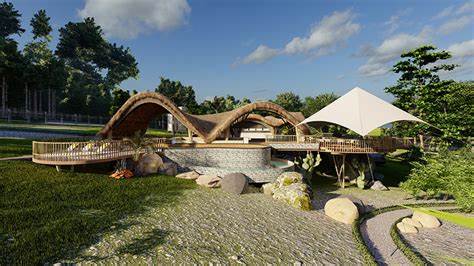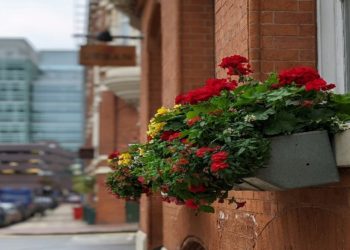Step into a realm where every corner holds a story, and every moment invites you to unwind and connect with the world around you. In the following pages, we dive into the captivating realm of resort design, where architects blend creativity with the symphony of the natural world.
From the gentle sway of palm trees to the crystalline waters that beckon, each resort serves as a canvas waiting to be painted with the hues of serenity and wonder. So, pack your sense of wonder and join us as we uncover the enchanting tapestry where architecture and nature intertwine in a dance of boundless charm and tranquility.
Main Takeaways
- Biophilic Design: Integrating nature into resort design enhances guest experiences, creating spaces that breathe and live.
- Landscape Integration: Resorts designed with the land in mind blend seamlessly into their surroundings, offering guests a unique connection to nature.
- Sustainable Practices: Embracing green roofs, native plantings, and solar orientation not only respects the environment but also enriches the guest experience.
- Views and Vistas: Thoughtfully framed views and fluid indoor-outdoor transitions invite the outside in, creating immersive natural experiences.
- Cultural Context: Incorporating local traditions and craftsmanship adds
Nature-Inspired Design Principles
1. Biophilic Design: Where Nature Takes Center Stage
Imagine stepping into a resort lobby and feeling like you’ve entered a serene forest glade. That’s the magic of biophilic design. It goes beyond adding a few plants; it’s about weaving nature into every aspect of the space. Curves that mimic rivers, textures reminiscent of tree bark, and colors straight from Mother Nature’s palette create an ambiance that’s more than just trendy—it’s a love letter to our planet.
2. Material Selection: Earth’s Treasures
Resorts that harmonize with nature understand the power of storytelling materials. Weathered wood with tales of storms, stones that have witnessed centuries, and meticulously crafted tiles—they’re not just materials; they’re whispers of history. Sustainability is the cherry on top. Picture walking into a spa pavilion with reclaimed teak floors, inviting you to connect with the past at every step. It’s not just about aesthetics; it’s about honoring our planet’s legacy.
3. Site Analysis: Listening to the Land
Before architects draw the first blueprint, they embark on a quest—the site analysis. They wander the land, feeling its heartbeat and hearing its stories. Where does the sun first peek over the horizon? Which tree cradles the moon? How does the wind dance with the cliffs? These aren’t mere questions; they’re the keys to unlocking the resort’s soul. It’s not just about the view; it’s about respecting the wisdom of the land.
Infusing these principles throughout the resort creates an environment where guests can unwind, reconnect with nature, and find a sense of peace. The use of organic materials, warm earthy tones, and thoughtful design elements evokes positive emotions, allowing visitors to rejuvenate in an oasis of tranquility
Blending In: Landscape Integration
1. Site-Specific Design: Resorts nestled in nature’s embrace exemplify site-specific design, where the architecture harmonizes with the landscape. Rolling hills and cliffside vistas become integral to the resort’s identity, with designs that honor the land’s natural contours and create a sense of peace and tranquility.
2. Outdoor Rooms: Outdoor rooms extend the luxury of the indoors to the natural world, offering guests a seamless transition to enjoy the beauty of their surroundings. Bamboo furnishings, terracotta accents, and comfortable seating invite relaxation, while larger windows and open layouts bring a sense of the outdoors inside.
3. Water Features: Water features are a cornerstone of resort design, providing a soothing presence that reflects the sky and landscape. Infinity pools, koi ponds, and fountains create a relaxing ambiance, allowing guests to reconnect with nature and find serenity in the ebb and flow of water.
Incorporating these design elements with careful consideration and attention to detail ensures that resorts offer an inviting atmosphere that bespeaks luxury and wellbeing, making them a central part of the hospitality experience in 2024 and beyond.
Views and Vistas: Crafting Serenity in Design
The Art of Framing
Architects, the maestros of perspective in hotel and resort interior designs, craft windows as portals to enchantment. Envision the sun painting the sea with fiery hues or the moon’s gentle ascent over mountain peaks—resort hotel design captures these moments, offering guests not just views but an emotional connection with the space.
Indoor-Outdoor Transitions
In the realm of hospitality interior design, the boundary between indoors and outdoors is artfully blurred. Glass doors disappear with a touch, merging the living room with the terrace, allowing guests to indulge in warm and welcoming earthy tones and vibrant colors that bring a sense of tranquility.
Private Balconies
Each guest suite boasts a private balcony, a personal haven where time pauses. Here, amidst neutral colors and shades of blue, guests enjoy solitude, surrounded by natural beauty and locally sourced materials like ceramics, mycelium, and palm fronds—elements that soothe and rejuvenate.
These design choices, from beach resort design ideas to coastal villas, reflect a stylish yet sustainable approach, ensuring that every resort interior space is an oasis of peace and calm. As we adapt to the pandemic, these resort design ideas have become central to creating inviting atmospheres that allow guests to feel connected and reconnect with nature.
Sustainable Practices: Harmonizing with Nature
Green Roofs: Where Nature Takes the High Road
- Envision a resort where the rooftops are transformed into thriving gardens. These green roofs are functional marvels, providing insulation and habitats, and becoming a central feature of resort hotel design. They offer guests a slice of Eden and are a testament to the resort design architects’ commitment to sustainability.
Native Plantings: Embracing the Locals
- Landscaping with native plants is a sustainable choice that resort design plans often highlight. These plants are not just aesthetically pleasing but also reduce water usage and maintenance, fostering a sense of calm and an emotional connection with the local ecosystem.
Solar Orientation: Catching Rays in Style
- Solar orientation plays a pivotal role in designing a hotel that basks in natural light. This strategic positioning is key to maximizing the environmental impact of natural heating and lighting, ensuring guest rooms are bathed in a warm glow, enhancing the upscale and welcoming atmosphere.
Blending these sustainable practices into the resort layout plans and hotel interiors not only brings a touch of nature closer to guests but also showcases the latest industry updates in eco-friendly design. Materials like mycelium and palm fronds, along with terrazzo finishes and taupe cushions, play a large part in creating spaces within the resort that soothe and rejuvenate, making each check-in an entry to an oasis away from the bustle.
Organic Forms and Materials
Curvilinear Architecture
Imagine a resort where buildings aren’t mere structures but reflections of the natural world. Curvilinear designs mimic hills, waves, and wind-swept dunes. These organic shapes feel like they belong, as if the resort itself has grown from the soil beneath our feet. It’s living in harmony with the land, one curve at a time.
Timber and Stone
Timber and stone are the ultimate power couple in building materials. Strong, sustainable, and carrying the essence of the earth, they whisper stories of ancient forests and rugged mountain ranges. These materials forge a tactile connection to nature, grounding the resort like roots in fertile soil.
Living Walls
Vertical gardens aren’t just eye candy; they’re green machines. They purify the air, muffle noise, and offer an ever-changing canvas that shifts with the seasons. Imagine strolling through corridors lined with verdant walls, the scent of fresh foliage filling the air, and the soft rustle of leaves serenading your steps. It’s not just aesthetics; it’s bringing the outdoors in, one living wall at a time.
These elements ensures that the resort design is more than just architecture—it’s an invitation to connect with nature and create lasting memories.
Cultural Context
Local Traditions: Where Past Meets Present
- A resort that honors local traditions in its architecture doesn’t just occupy a landscape—it becomes an integral part of it. It’s a narrative woven by resort design architects, telling the story of the land and its people. Incorporating local traditions, from intricately carved facades to vibrant murals, transforms the resort into a living storyteller, each corner a whisper of the past, inviting guests to connect deeply with the heritage
Artisan Craftsmanship: Handcrafted Magic
- Collaborating with local artisans infuses the resort with the soul of the community. Every handcrafted detail, from woven textiles to carved woodwork, is a testament to skill and tradition. These elements, often incorporating natural materials like mycelium, foster an emotional connection with the space, enveloping guests in authenticity and warmth.
By integrating these cultural elements, the resort becomes more than a place to stay—it becomes a journey of discovery and connection, where design style and hrds (hotel and resort design services) play a pivotal role in bringing the outside in, creating design spaces that resonate with the spirit of the locale.
FAQ’s: Your Resort Design Questions Answered
What is resort style interior design?
A: Resort style interior design evokes the feel of a luxurious getaway, often incorporating natural materials like wood, stone, and rattan, along with bright colors, flowing lines, and relaxing fabrics to create an inviting and relaxed atmosphere.
How to design a resort plan?
A: Designing a resort plan involves understanding the target market and location, choosing architectural styles that align with the resort’s theme, exploring local culture for inspiration, and incorporating sustainable design principles. It’s about creating a symbiotic relationship with the natural surroundings and ensuring the resort’s design is harmonious with the environment.
What type of architecture is a resort?
A: Resort architecture varies widely but typically includes designs that are harmonious with the surrounding environment, whether it’s a beachside retreat or a mountain lodge. It often involves using natural materials and creating spaces that offer guests a unique and immersive experience.
What is the concept of a resort?
A: The concept of a resort is to provide guests with a comprehensive experience away from home, offering a range of services and facilities such as food, drink, accommodation, sports, entertainment, and shopping, all in one location. Resorts are designed to cater to various traveler needs and are often situated in scenic or exotic locations.
What is the characteristic of a resort?
A: Characteristics of a resort include luxury amenities, scenic locations, activities for all ages, personalized service, and an exclusive atmosphere. Resorts aim to provide a complete package of entertainment and relaxation options to make stays comfortable and enjoyable.
How can I make my resort attractive?
A: To make a resort attractive, have a clear vision, use social media effectively, offer unique services, pay attention to details, aim for 5-star service, keep upgrading, and offer plenty of on-site activities for guests. It’s also important to focus on creating an experience that stands out and makes guests want to return.
Conclusion: A Symphony of Nature and Design
As day turns to dusk, the resort comes alive, pulsing with energy and possibility. It’s more than just a collection of buildings; it’s a living, breathing organism—a symphony of nature and design. Within its walls, stories unfold, laughter dances in the air, and connections are forged that last a lifetime.
So, the next time you find yourself in a resort, take a moment to pause and listen. You’ll hear the gentle rustle of leaves, the fragrant whispers of jasmine, and the subtle symphony of the natural world. It’s not just about luxury; it’s about life in its purest form—a harmonious blend of human ingenuity and the beauty of the world around us. Tanic resort design services weave this magic, creating spaces where guests can immerse themselves in the symphony of nature and design, forging memories that resonate long after they’ve checked out











































































